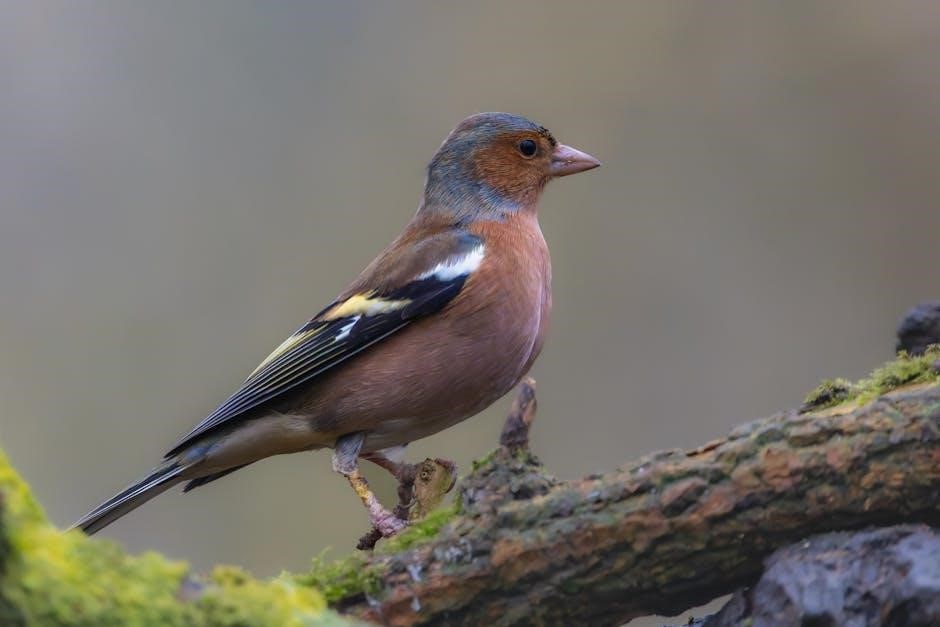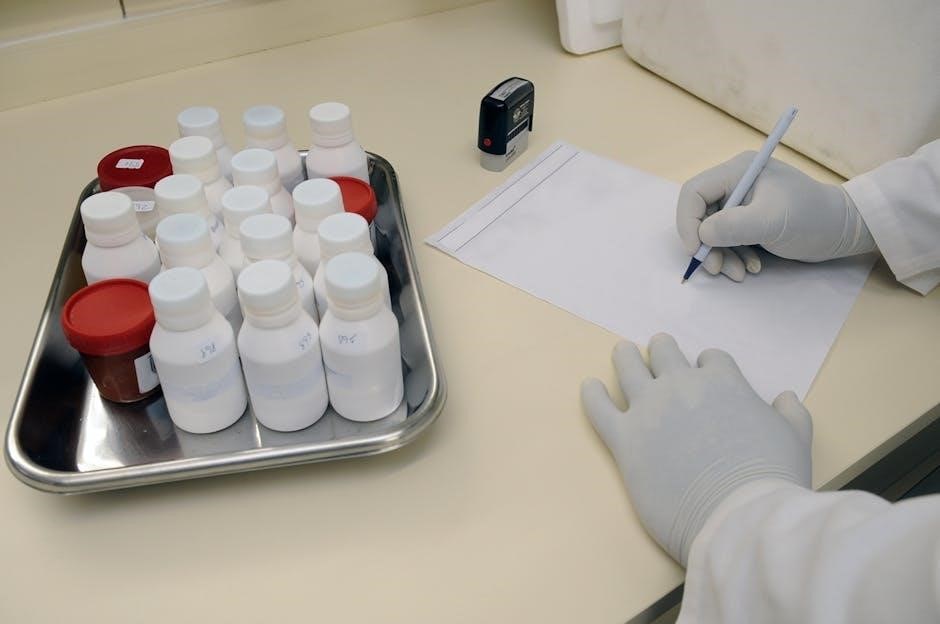This lab simulates natural selection through competition, using tools to represent finch beaks․ Students explore how beak adaptations influence survival and reproduction, mirroring Darwin’s finch observations․
1․1 Overview of the Lab Activity
The Beaks of Finches Lab is a hands-on activity simulating natural selection․ Students use tools like tweezers, spoons, and pliers to represent finch beaks, competing to collect seeds; The lab begins with individual trials, where students test their “beaks” on small seeds, followed by competition rounds․ Data on seed collection efficiency is recorded and averaged to determine which beak type performs best․ This setup mimics ecological competition, allowing students to observe how specific traits influence survival and reproduction․ The activity concludes with discussions on natural selection and adaptation, aligning with Darwin’s observations of finch diversity in the Galapagos․
1․2 Importance of Finch Beaks in Evolutionary Studies
Finch beaks are a cornerstone of evolutionary biology, exemplifying how small anatomical differences can drive species divergence․ Their varied shapes and sizes, as observed by Darwin, reflect adaptations to specific ecological niches, such as seed size and type․ This diversity demonstrates natural selection’s role in shaping traits that enhance survival and reproductive success․ The study of finch beaks provides empirical evidence for adaptive radiation, showcasing how environmental pressures can lead to specialization․ These observations are pivotal in understanding evolutionary mechanisms and the origins of biodiversity, making finches a timeless model in evolutionary research․

Objectives of the Lab
This lab aims to simulate natural selection, demonstrating how finch beak traits influence survival․ Students analyze adaptation and competition, linking beak morphology to feeding efficiency and reproductive success․
2․1 Understanding Natural Selection Through Finch Beaks
Students explore natural selection by observing how different beak tools affect seed collection efficiency․ This simulation reveals how environmental pressures favor certain traits, leading to species survival and adaptation․ By analyzing data, participants understand how specific beak shapes and sizes confer advantages in gathering food, mirroring Darwin’s observations of finch evolution on the Galapagos․ This hands-on approach clarifies the role of competition and resource availability in driving evolutionary changes, making abstract concepts tangible and relatable․
2․2 Analyzing Adaptation and Competition
This section focuses on how different beak types adapt to specific food sources, influencing competition among finches․ By simulating environmental pressures, students observe which beak tools are most efficient at collecting seeds, demonstrating adaptation․ Larger beaks excel with tougher seeds, while smaller beaks handle smaller ones better․ Competition rounds reveal how resource availability drives survival, showcasing natural selection’s role in shaping species traits over time․ This hands-on analysis highlights how adaptive traits confer advantages, enabling some finches to outcompete others in varying ecological scenarios․
Materials and Tools Used
The lab uses tools like tweezers, spoons, pliers, chopsticks, and binder clips to simulate finch beaks․ Seeds of varying sizes represent food sources, challenging students to adapt effectively․
3․1 Beak Representations (Tweezers, Spoons, Pliers, etc․)
Various tools simulate finch beaks, such as tweezers, spoons, pliers, chopsticks, and binder clips․ Each tool represents different beak shapes and sizes, mimicking natural adaptations․ Tweezers mimic sharp, pointed beaks, ideal for small seeds, while spoons represent broad, flat beaks suited for larger seeds․ Pliers symbolize strong, thick beaks for tough seeds, and chopsticks reflect slender, precise beaks․ These tools allow students to test hypotheses about adaptation and competition, demonstrating how beak traits influence survival and reproductive success in different environments․ This hands-on approach makes evolutionary concepts tangible and engaging for learners․
3․2 Seeds and Food Sources
Seeds of varying sizes and types are used to simulate food sources available to finches․ Small seeds represent easily accessible food, while larger seeds mimic tougher, less accessible resources․ The diversity in seed sizes and shapes allows students to explore how different beak adaptations influence feeding success․ This setup reflects real-world ecological challenges, where finches must compete for limited food resources․ By analyzing seed collection efficiency, students observe how natural selection favors certain traits, linking beak morphology to survival and reproduction․ This hands-on approach bridges theoretical concepts with practical experimentation, enriching the understanding of evolutionary mechanisms․

Lab Procedures
Students simulate natural selection by using beak tools to collect seeds, competing in rounds to test adaptation efficiency․ Procedures include setup, individual trials, and competition rounds․
4․1 Setup and Initial Predictions
The lab begins with arranging materials, including various beak tools (tweezers, spoons, pliers) and seeds of different sizes․ Students predict which beak type will be most efficient at picking up seeds․
They record their hypotheses, considering how beak shape and size might influence feeding success․ These predictions guide the experiment, helping students understand how natural selection favors specific traits․ The setup ensures a controlled environment for testing adaptation and competition, aligning with evolutionary principles observed in finch species․
4․2 Conducting Individual Trials
Students conduct individual trials using their assigned beak tools to pick up seeds of varying sizes․ Each trial lasts a set time (e․g․, 20 seconds), during which they collect as many seeds as possible․ After three trials, they calculate the average number of seeds collected․ This step allows students to assess their beak’s efficiency in different scenarios, simulating how finches adapt to specific food sources․ The data collected helps students understand how natural selection favors beak traits that enhance feeding success, aligning with evolutionary principles observed in finch populations․
4․3 Competition Rounds
In competition rounds, multiple students or groups with varying beak tools simultaneously collect seeds, mimicking real-world ecological competition․ Each round lasts 20 seconds, and the number of seeds gathered is recorded․ This step introduces direct competition for resources, allowing students to observe which beak types outperform others․ The beak’s efficiency in securing food under competitive pressure is critical, as it determines survival and reproductive success․ Data from these rounds is analyzed to draw conclusions about adaptation and natural selection, reflecting evolutionary principles demonstrated by finches in the Galapagos Islands․ This phase highlights how environmental pressures drive species specialization․
Data Collection and Analysis
Students record seed counts for each beak type, calculate averages, and compare efficiencies․ This analysis reveals which beak adaptations are most advantageous, linking to evolutionary insights․
5․1 Recording Seed Collection Efficiency
During the lab, students systematically record the number of seeds each beak tool collects within a set time․ This involves observing and noting the efficiency of tweezers, spoons, pliers, and other tools in picking up seeds․ The data is collected across multiple trials to ensure accuracy and reduce variability․ Each trial’s results are documented, allowing for a clear comparison of how different beak adaptations perform in seed collection․ This process mimics natural selection by demonstrating which traits are most advantageous for survival․ The recorded data serves as the foundation for subsequent analysis and discussions on evolutionary principles․
5․2 Calculating Averages and Comparisons
After recording seed collection data, students calculate the average number of seeds collected per trial for each beak tool․ This involves summing the seeds collected across trials and dividing by the number of trials․ Comparisons are then made between different beak types to determine which tool was most efficient․ This step highlights how specific traits, like beak shape and size, influence survival and reproductive success․ The averaged data allows for clear conclusions about adaptation and competition, providing insights into evolutionary principles observed in natural environments, such as the Galapagos Islands․

Key Questions and Answers
Which beak type is most suited for specific seeds? How does competition affect survival? Answers reveal how natural selection drives adaptation, favoring traits that enhance survival․
6․1 Predicting Finch Survival Based on Beak Type
Predicting finch survival involves analyzing beak morphology and seed characteristics․ Large ground finches, with robust beaks, excel at cracking large seeds, ensuring survival during food scarcity․ Small tree finches, equipped with slender beaks, thrive on smaller seeds․ Environmental changes, such as shifts in seed size, favor specific beak types, driving natural selection․ This lab demonstrates how adaptations like beak shape and size determine a species’ ability to compete and survive, aligning with Darwin’s observations on finch diversity in the Galapagos Islands․
6․2 Analyzing Food Sources and Finch Specialization
Finch specialization is influenced by food availability and beak adaptations․ Large ground finches thrive on tough seeds, while small tree finches prefer insects․ Beak shape determines efficiency in accessing specific food types, reducing competition․ In the lab, tools mimic beaks, showing how certain traits excel in gathering particular seeds․ This specialization highlights evolutionary adaptations, enabling coexistence of finch species by exploiting different resources․ The lab underscores how environmental pressures shape traits, aligning with Darwin’s observations of niche partitioning among Galapagos finches, where diverse diets ensure ecological balance and species survival․

Discussion and Implications
The Beaks of Finches lab effectively models natural selection, showing how beak traits influence survival․ It demonstrates real-world evolutionary principles, linking adaptation to environmental pressures․
7․1 Validity of the Lab as a Model for Natural Selection
The Beaks of Finches lab is a robust model for natural selection, as it demonstrates how environmental pressures drive adaptation․ By using tools to simulate finch beaks, the activity shows how specific traits confer advantages in resource acquisition․ The controlled setup allows students to observe how different beak shapes affect survival and reproduction success, mirroring real-world evolutionary processes․ This hands-on approach effectively illustrates key concepts of natural selection, such as competition, adaptation, and differential reproductive success, making it a valuable educational tool for understanding evolutionary biology․
7․2 Real-World Applications of the Lab Concepts
The Beaks of Finches lab offers insights into real-world ecological dynamics, such as species adaptation and competition․ By studying beak traits, scientists can understand how environmental changes influence biodiversity․ This lab’s concepts apply to conservation biology, helping predict how species might adapt to habitat alterations or climate change․ Additionally, the principles of natural selection demonstrated in the lab are crucial for understanding invasive species dynamics and maintaining ecosystem balance․ These applications highlight the importance of evolutionary biology in addressing contemporary environmental challenges․
The Beaks of Finches lab effectively demonstrates natural selection and adaptation, providing insights into evolutionary principles․ It highlights how environmental pressures shape species survival and diversity over time․
8․1 Summary of Lab Findings
The lab revealed that finch beak variations significantly impact feeding efficiency and survival․ Tools mimicking different beaks showed varied success in seed collection, with specific beaks excelling under certain conditions․
Competition rounds demonstrated how environmental pressures influence adaptation, favoring beaks best suited to available food sources․ Data comparisons highlighted survival advantages linked to beak specialization, aligning with evolutionary principles observed in nature․ These findings underscore the role of natural selection in shaping species traits, providing practical insights into Darwin’s theory through experimental simulation․
8․2 Relevance to Evolutionary Biology
The Beaks of Finches lab offers a practical demonstration of natural selection and adaptation, core concepts in evolutionary biology․ By simulating environmental pressures, the activity illustrates how specific traits, like beak shape and size, confer survival advantages․ This aligns with Darwin’s observations of finch diversity on the Galapagos Islands, highlighting how species adapt to ecological niches․ The lab not only reinforces theoretical knowledge but also provides empirical evidence for evolutionary principles, making it a valuable educational tool for understanding the mechanisms driving biodiversity․
- Demonstrates adaptation to environmental pressures․
- Illustrates competition for resources and survival․
- Supports Darwin’s finch observations․

